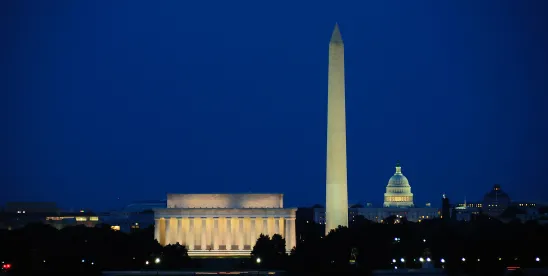July was a big month for federal energy and sustainability policy. A series of major actions out of Congress and the executive branch signaled significant shifts in direction — on everything from spending and permitting to trade, technology, and agency leadership. With competing FY26 spending bills advancing in the House and Senate, the divide over clean energy funding and climate priorities is becoming even more pronounced.
At the center of the action was President Trump’s signing of the One Big Beautiful Bill (H.R. 1) on July 4, which rewrites major portions of the Inflation Reduction Act (IRA) and launches a new Energy Dominance Loan Program focused on boosting energy output and grid reliability. The administration also released a national AI and data center strategy aimed at accelerating infrastructure buildout, loosening permitting rules, and ramping up workforce development. At the same time, the Department of Defense announced a landmark $1 billion partnership to onshore the rare earth magnet supply chain, and the White House rolled out new tariffs targeting Chinese graphite.
Key personnel changes are also underway, with new nominations at FERC, DOE, and EPA pointing to a broader realignment of federal energy priorities. As we head into the fall, the pace of change is likely to pick up even more — especially with the FY26 budget deadline and potentially a required debt ceiling extension approaching in September.
The One Big Beautiful Bill
As noted in an article we put out earlier this month, President Donald Trump signed H.R. 1 — the One Big Beautiful Bill (OBBB) — into law on July 4, 2025, making significant changes to energy tax provisions enacted under the 2022 Inflation Reduction Act. The bill also establishes the Energy Dominance Loan Program, expanding Section 1706 loan authority to support projects that increase energy output or improve grid reliability, without requiring emissions reductions or technical innovation. Backed by a $1 billion credit subsidy through 2028, the program could enable up to $15 billion in loans across the energy and critical minerals supply chain, though nuclear projects may rapidly absorb this capacity.
FY26 Appropriations Update
On July 24, the Senate Appropriations Committee approved a $38.6 billion package to fund EPA, the Interior Department, and related agencies — $600 million above the House GOP’s version. EPA would receive $8.6 billion, a 6% cut from FY25 but much less severe than the 23% cut proposed by House Republicans. Meanwhile, EPA is undergoing internal restructuring, merging its Office of the Chief Financial Officer with Mission Support and continuing layoffs and buyout offers. The Department of the Interior would receive $15.1 billion, a 2% reduction, aligned with House levels but significantly above the $10.5 billion White House request.
On July 17, the House Appropriations Committee passed a $57.3 billion energy and water spending bill, including $48.8 billion for the Department of Energy — $1.4 billion below FY25 levels. Funding prioritizes nuclear energy, critical minerals, and water infrastructure while slashing clean energy accounts. The bill would eliminate the Office of Clean Energy Demonstrations (OCED) and cut the Office of Energy Efficiency and Renewable Energy (EERE) by nearly 50%, with an additional $20 million cut approved by amendment. The Office of Fossil Energy would also see a major decrease in funding under the bill, though Republicans said the office would be refocused on “reliable, efficient, and cost effective” fossil fuel generation and critical minerals.
Several offices would see slight increases in their funding under the proposal, including the Office of Science, Office of Nuclear Energy, Office of Indian Energy Policy and Programs, and Office of the Inspector General. Republicans said the increase for the Office of Science would allow DOE to accelerate research into quantum computing, AI, and fusion energy. The Office of Cybersecurity, Energy Security, and Emergency Response would be kept flat. The bill largely maintains funding for the Loan Programs Office (LPO), with a $150 million boost in the credit subsidy for the nuclear energy projects under the Title 17 Innovative Technology Loan Guarantee Program.
The bill would also rescind $5.1 billion in unobligated balances from Bipartisan Infrastructure Law programs, including for clean hydrogen hubs, direct air capture hubs, and carbon dioxide transportation infrastructure. The $5.1 billion would be redirected to the Advanced Reactor Demonstration Program.
DOE has continued to emphasize nuclear, and recently announced the start of a new pilot program to accelerate the development of advanced nuclear reactors and strengthen domestic supply chains for nuclear fuel. DOE issued a Request for Application (RFA) and is seeking qualified US companies to build and operate nuclear fuel production lines using the DOE authorization process. Initial applications are due by August 15, 2025, with subsequent applications allowed on a rolling basis.
The Senate is expected to strip many of the House’s cuts and policy riders, and a continuing resolution may be needed if Congress doesn’t pass appropriations bills by the September 30 deadline.
New Permitting Landscape
The Department of the Interior announced that all wind and solar projects now need Interior Secretary Doug Burgum’s personal sign-off to receive permits, including leases, rights-of-way, construction and operation plans, grants, consultations, and biological opinions. Interior also eliminated longstanding right-of-way and capacity fee discounts for existing and future wind and solar projects, and said it will be reviewing all regulations within 45 days to identify any preferential treatment for renewables over dispatchable energy sources.
DOE’s Loan Programs Office also terminated a pending $4.9 billion loan guarantee for the Grain Belt Express project, a fully permitted transmission line intended to carry mostly wind-generated power across Kansas and Missouri. DOE is conducting a review of every applicant and borrower “to ensure every single taxpayer dollar is being used to advance the best interest of the American people.”
Simultaneously, multiple agencies — including Interior, Energy, Defense, and Agriculture — are revising NEPA procedures via interim final rules, bypassing typical notice-and-comment periods. Key changes include eliminating draft environmental impact statements and narrowing the scope of environmental impacts that must be considered.
Congressional Republican leadership has also stated that the GOP will prioritize advancing bipartisan permitting legislation this fall. On July 25, House Natural Resources Committee Chair Bruce Westerman (R-AK) and Rep. Jared Golden (D-ME) introduced the Standardizing Permitting and Expediting Economic Development Act or SPEED Act. The bill would target NEPA by simplifying the scope of review by removing requirements to consider or conduct new scientific or technical research. The text would mandate that federal agencies are not permitted to delay the issuance of an environmental review document or decision on the basis of waiting for new scientific research to be released, and would limit reviews to only considering environmental impacts that “share a reasonably close causal relationship to and are proximately caused by” the immediate project or action undergoing the permitting process. Representative Westerman attempted to push through similar permitting reforms during the last Congress, working alongside Sen. John Barrasso (R-WY) and then-Sen. Joe Manchin (I-WV).
White House AI and Data Center Action Plan
On July 23, the White House released a sweeping AI Action Plan designed to cement US leadership in artificial intelligence through deregulation, infrastructure expansion, and global tech diplomacy. The AI Action Plan calls for expedited permitting for data centers and chip fabs, and national workforce initiatives to fill high-demand roles like electricians and HVAC technicians. The blueprint recommends establishing new categorical exclusions under NEPA to cover data center–related actions that normally do not have a significant effect on the environment. It also recommends speeding environmental permitting by streamlining or reducing regulations set forth by laws including the Clean Air Act, Clean Water Act, and Comprehensive Environmental Response, Compensation, and Liability Act. The plan further suggests directing agencies with significant land portfolios to make federal lands available for data center and power generation infrastructure construction. Subsequently, DOE announced the selection of four sites — Idaho National Laboratory, Oak Ridge Reservation, Paducah Gaseous Diffusion Plant, and Savannah River Site — for AI data center and energy infrastructure development. More detail can be read in our article here.
New Tariffs on Chinese Graphite
The Trump administration announced preliminary tariffs on Chinese imports of graphite active anode material, following a Commerce Department finding that Chinese firms are dumping the product in the US at unfairly low prices. This determination, prompted by a coalition of North American producers, led to a 93.5% antidumping duty — lower than the 900% sought but still a significant win for domestic companies, who argue China’s market manipulation is undermining US industry. The effective tariff rate now totals about 160% when combined with earlier duties and tariffs, and further increases may result from the administration’s ongoing Section 232 investigation into critical mineral imports.
DoD Commits Over $1 Billion to Build US Rare Earth Magnet Supply Chain
The Department of Defense (DoD) announced a landmark public-private partnership with MP Materials, committing over $900 million in funding and financing to expand domestic rare earth magnet production and reduce dependence on China. The deal includes $400 million in equity investment, a potential $350 million in additional equity, and a $150 million loan to expand heavy rare earth processing — specifically samarium — at MP’s Mountain Pass facility. It also establishes a second US-based magnet manufacturing site (“10X Facility”), a 10-year price floor for neodymium-praseodymium (NdPr), and a long-term offtake agreement for all magnet output. In exchange, the DoD secured equity rights of up to 15% of MP’s shares and placed strict national security controls on future foreign transactions, including ending ties with Chinese-linked Shenghe Resources by 2026.
This agreement, one of the largest Defense Production Act investments to date, is expected to catalyze more than $1 billion in private capital, including $600 million from MP and $1 billion in committed debt financing. The partnership aims to close the strategic gap in rare earth magnet manufacturing — an area where China holds over 90% of global capacity — by creating a vertically integrated US supply chain. While the deal provides a major boost to US critical minerals resilience, it also ties MP’s future closely to federal procurement and funding stability, signaling a new model for national security–driven industrial policy.
FERC and Other Nominations
President Trump nominated David LaCerte to serve on the Federal Energy Regulatory Commission, shifting FERC to a Republican majority. LaCerte currently works as the principal White House liaison and senior adviser to the Office of Personnel Management’s director and was a contributor for Project 2025. Prior to joining OPM, LaCerte was a special counsel at Baker Botts, where he was involved in some energy litigation, and he served as senior adviser and executive counsel at the US Chemical Safety Board. However, some FERC officials point out that this isn’t the typical background for commissioners at FERC.
The Senate also confirmed Wells Griffith as DOE Under Secretary for Energy and Aaron Szabo as Assistant Administrator for EPA’s Office of Air and Radiation, which has responsibility for the Energy Star program. Other key nominations advancing include David Wright to chair the Nuclear Regulatory Commission and Usha-Maria Turner to lead EPA’s Office of International and Tribal Affairs.





 />i
/>i

